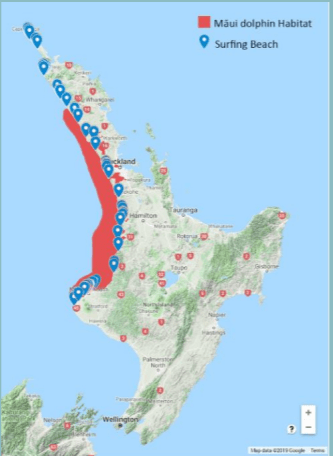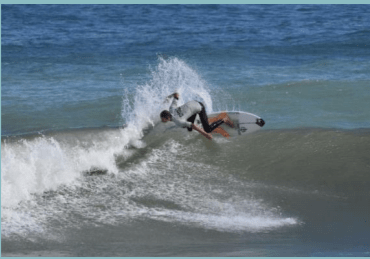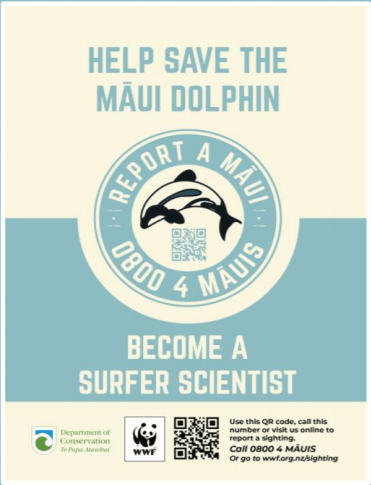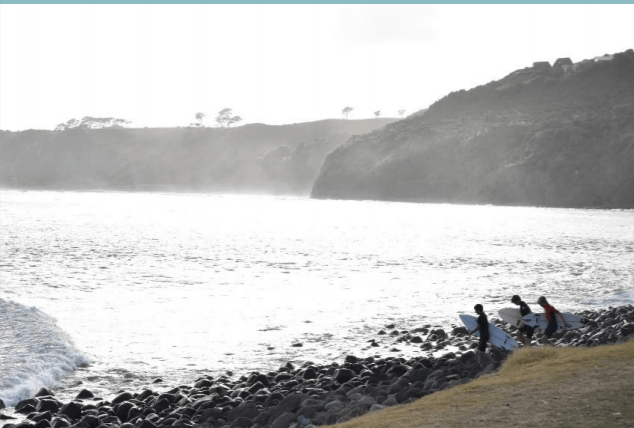Executive Summary
Background
The Māui dolphin (Cephalorhynchus hectori Māui), also called Māui’s dolphin, is a subspecies of Hector’s dolphin that is endemic to the West Coast of New Zealand’s North Island. The Māuidolphin is physically identical to Hector’s dolphin, pictured below. The Māui dolphin is critically endangered, with estimates suggesting that only around 60 dolphins remain (Baker et al. 2016). Several threats affect Māui dolphin’s chance of survival. The most prominent threat stems from dangerous fishing practices that result in the bycatch of Māui dolphins. Currently, the species can only withstand one human-induced death every 10 to 23 years to stand a chance at population rebound. However, recent estimates suggest that an average of 5.27 Māui dolphin deaths occur each year as a result of fishing practices (Curry et al. 2012).
To combat the trend in declining dolphin numbers, the NewZealand Department of Conservation (DOC) and the World WideFund for Nature-New Zealand (WWF) have been driving efforts forMāui habitat protection. The New Zealand Government has devised the Spatially Explicit Fisheries Risk Assessment (SEFRA) to gain an understanding of the interplay between fisheries and the Māuidolphin population. SAFRA is a modeling system that maps the distribution of the Māui dolphin and compares that range to areas where dangerous fishing practices take place. This estimates the risk that the fishing industry poses to the dolphins (Lonergan, Phillips, Thomson & Zhou, 2017). SAFRA utilizes verified sightings from NewZealand citizens and scientists to map this distribution. A large portion of these reports come from surfers who are active in the same area as the dolphins.
Spatial Overlap of Māui Dolphin Habitat and West Coast Surfing Beaches.
While SEFRA currently has data on the number of dolphins spotted across the coast, it is unable to estimate the density of the dolphins based on surfer sightings because there is no measure of effort from the surfing population. Effort varies spatially, which can lead to disparities between the actual number of dolphins and the number of dolphins that are reported. A value is needed to estimate the probability that the presence of a Māui dolphin will be reported, and that also accounts for factors that vary by location. This value is termed surfer effort, but the variables that constitute it are not well defined. By defining and collecting data regarding surfer effort, SEFRA scientists will be able to map the spatial density of the Māui dolphin along with its range (Jim Roberts and Ben Sharp, personal communication, January 11, 2019).
Surfer at Point Boardriders Club Local Surf Competition 2019, Manu Bay, Raglan (Reiniger, 2019).
Goals, Objectives, and Methods
This project aimed to develop a method for estimating the spatial distribution in surfer effort along the West Coast of the North Island of New Zealand. It also aimed to promote the importance of reporting Māui dolphin sightings to the surfing population in this region. To achieve these goals, we designed the following objectives
Objective 1: Identify key surfing beaches and virtual communities that have the potential to provide the necessary data on surfing populations. The team consulted with SEFRA scientists Ben Sharp and Jim Roberts to identify locations to survey. We targeted surfing beaches as well as virtual communities. To narrow down the possible range of social media pages and internet forums, the team chose pages that had the criteria of being surfing or conservationist related and had members that are from the North Island of New Zealand.
Objective 2: Identify the factors that prevent the use of surfer sightings in SEFRA. Define the values that constitute surfer effort. The team conducted interviews with key individuals including Ben Sharp, Jim Roberts, Laura Boren, and Amanda Leathers. In all interviews, we addressed questions regarding how SEFRA works, what prevents surfer sightings from being used in the system, and how to address the data needs of SEFRA through survey questions. Following the interviews, we developed a more solidified concept of surfer effort and the data needed to define it.
Objective 3: Gather data regarding spatial distribution, density, and reporting habits of surfers along the West Coast of New Zealand’s North Island using a participatory survey. The team created a survey using an online survey and data analysis application. The survey was designed to satisfy three criteria: it should gather relevant data regarding surfer effort, be time-efficient, and be user-friendly. We evaluated the effectiveness of the survey based on several measures such as quantity and frequency of responses, average completion time, and the average score received from a survey satisfaction question.
Objective 4: Promote awareness of the Māui dolphin and the importance of becoming a surfer scientist by reporting sightings of the subspecies. To promote awareness, we created awareness of campaign materials. A sticker and a matching flyer were designed with consideration from the WWF and DOC. These materials included suggested ways to report sightings. The stickers were given to survey participants and distributed to the surf shop. The flyers were posted surfing beaches and locations such as surf shops, cafes, and hostels.
Findings, Conclusions, and Recommendations
Finding 1: Surfing-related Facebook and Reddit pages, as well as the physical locations of Raglan, Piha, and New Plymouth, were selected as communities to be surveyed.
Raglan Town Center (Reiniger, 2019)
Based on our conversations with Ben Sharp and Jim Roberts, the team identified Raglan, Piha, and New Plymouth as important surveying locations. These locations contain large surfing communities and fall within the Māui dolphin habitat. Due to time constraints, we were only able to do in-person surveying in Raglan. Additionally, we identified Facebook and Reddit as platforms to post our survey. The survey was posted to Facebook pages including SURFING Stock Exchange, Surfing New Zealand Discussion Group, NZSurfers Group, and Raglan Surf School. Also, Peggy Oki, contact in Raglan, posted the survey on Let’s Face It Visual Petitions Facebook Page, which advocates for Māui dolphin conservation. Peggy Oki also contacted Christine Rose, a member of the Muriwaicommunity, who posted the survey to the Muriwai community page, the Dolphin Defenders NZ page, and the Cetacean Spotting page. The team posted the survey to the New Zealand subreddit on the Redditinternet forum as well.
Raglan Side Street (Reiniger, 2019).
In Raglan, we surveyed three main beaches: Manu Bay, Ngarunui Beach, and Whale Bay. While all these beaches neighbor each other, they each have different conditions and therefore draw different demographics. We found that breaks with popular waves as well as an area to sit and rest provided the best opportunity for surveying the Raglan Surfing community. This combination of making people more willing to talk with us and participate in the survey.
Finding 2: Surfer effort is a complex statistic composed of values including the density of surfers, how likely the surfers are to report a sighting, and the number of days surfers are available to make a sighting. According to interviews with Ben Sharp and Jim Roberts, surfer sightings cannot be used in the SEFRA system because there is too much statistical variability between locations sightings are reported from. Key variables differ between spatially explicit areas, including the density of surfers, the number of days surfers inhabit the beach, and how likely the surfers are to report a sighting. All these factors can create a discrepancy between the number of dolphins reported and the actual density of dolphins. This must be mathematically factored in to convert the number of sightings intensity in each reporting area.
Finding 3: The survey gathered data regarding spatial distribution, density, and reporting habits of surfers needed for SEFRA. Following our interview with Ben Sharp and Jim Roberts, we edited our original survey to include questions aimed at finding out the surfing frequency and most popular surfing locations, as well as the likeliness of reporting a Māui dolphin sighting from a surfer. Upon distributing the survey to selected Facebook groups, we obtained 34 responses. The greatest peak in responses occurred within a day of posting the survey. The post to the New Zealandsubreddit resulted in 12 responses within the first three days. The subreddit post also received somewhat negative comments from users sharing the opinion that it was too late to save the Māuidolphin and that the subspecies “was already extinct”.Mobile Phone Survey (Reiniger, 2019). In-person surveying in Raglan resulted in 36 responses. From the survey, we collected data such as several days surfed, the number of surfers seen on average per day, most popular surfing phone applications and websites, and the likelihood of reporting a sighting. Using respondent feedback, we constructed a finalized survey to best collect surfer effort data.
Finding 4: We created and distributed stickers and flyers that promote awareness of the Māui dolphin as well as the importance of reporting dolphin sightings. The finalized sticker and poster design had the same theme and were visually appealing. They were well received by surfers and locals and posted around Raglan. On multiple occasions, survey participants asked if they could have more than one. Many said they liked the color scheme and were visually attracted to them before reading the content.
Distributed Flyer Design.
Conclusion
Through feedback consideration, survey improvements and data analysis based on our initial discussion with Ben Sharp and Jim Roberts, we concluded that the survey was effective in gathering data components of surfer effort. By providing the SEFRA scientists with these data, we helped them estimate effort and incorporate surfer sightings of the Māui dolphin into the SEFRA modeling system. The addition of this data to SEFRA maps will allow scientists to make recommendations to the government regarding fishing restrictions. By testing various distribution pathways, we found that the most effective way to gather data from New Zealand’s North Island surfing community was through in-person surveying because increased participant engagement. In-person distribution gave participants more incentive to take, complete, and provide feedback on the survey in a way that the online surveys fell short. Due to the increased engagement from this surveying method, our effort to increase participation and awareness of reporting sightings was also promoted.
Based on the positive reactions that respondents had when they received a sticker or a flyer, we determined that the awareness materials were successful. Surfers enjoyed the design and were enthusiastic about using them to get involved in reporting sightings and spreading awareness for the Māui dolphin on their own. Before this project, there was minimal information regarding effort values for citizen science-based mapping. Our developed concept of surfer effort can be used as a model of how to synthesize a spatial effort value and therefore can provide legitimate value to projects which map comparative spatial variation phenomena or events using citizen science.
Surfers at Manu Bay (Reiniger, 2019).
Recommendations
Based on these findings, we recommended that the WWF and/or DOC:
1. Continue to increase the number of surveyed beaches and communities by expanding surveying efforts
2. Form partnerships with local organizations hosting surfing competitions to distribute the survey and awareness materials
3. Increase online conservation and data collection efforts
4. Repeat the survey in the winter months to obtain seasonal surfer effort estimations
5. Continue to distribute our awareness materials, including at Raglan’s Māui dolphin Day.
6. Re-print the designed stickers to be waterproof so they can be placed on surfboards, cars, and boats.
7. Analyze the effectiveness of awareness materials by measuring the number of reported sightings in Raglan after the flyers and stickers were distributed and comparing it to the number of reported sightings before.
8. Use the emails compiled from the survey to create a Māuidolphin supporter group
9. Encourage the reporting of all rounded-fin dolphin sightings the North Island, regardless of whether the reporter believes the dolphin is a Hector’s or Māui.
10. Distribute both an online and mobile phone version of the survey to increase the user-friendliness of the questions








